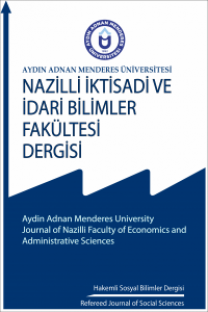DÜNYADA CARİ DENGESİZLİKLERİN SON 40 YILI: KRİZLERİN VE DIŞ TİCARET HESABININ ROLÜ
Küreselleşme ile birlikte 1980’li yıllardan sonra ülkelerin sermaye akımları önündeki engelleri kaldırması sonucunda yaşanan yüksek sermaye girişleri, ülkelerin daha rahat borçlanabilmesine imkân sağlamıştır. Bunun sonucunda ise birçok ülkede cari açıklar süreklilik kazanmaya başlamıştır. Özellikle 1990’lı yıllardan itibaren giderek büyüyen ve sürekli hale gelen cari açıklar, politika yapıcıların ve iktisatçıların dikkatini çekmiş ve cari açıkların sürdürülebilir olup olmadığı konusunu gündeme getirmiştir. İktisatçılar arasında cari açığın sürdürülebilirliğinin tespitine yönelik bir fikir birliği bulunmamaktadır. Bu çalışmanın amacı betimsel analiz yöntemleriyle dünyada ve seçili ülke/ülke gruplarında cari dengenin yıllara göre seyrini incelemek, küresel ve bölgesel krizlerin cari dengeye etkisini görmek ve cari açık/fazla veren ülkelerde bu açık/fazlanın sebeplerini irdelemektir.
Anahtar Kelimeler:
Cari İşlemler Hesabı, Cari Açık, Cari Açığın Sürdürülebilirliği, Dış Ticaret Hesabı, Betimsel Analiz
THE LAST 40 YEARS OF CURRENT IMBALANCES IN THE WORLD: THE ROLE OF CRISES AND TRADE BALANCE
With the effect of globalization, after the 80s, the high capital inflows experienced as a result of the elimination of obstacles to capital flows, enabled countries to borrow more easily. As a result, current account deficits started to gain continuity in many countries. Especially starting with the 90s, the current account deficits, which have been growing and becoming permanent, attracted the attention of policy makers and economists and brought up the issue of whether current account deficits are sustainable or not. Although there is no consensus among economists regarding the determination of the sustainability of the current account deficit, it has been observed in the literature that the subject is addressed with econometric methods. The purpose of this study is to present a different view by examining the current account balance in the world and selected country / country groups historically, to see the effect of global and regional crises on the current account balance and to examine the reasons of this imbalances with descriptive analysis.
Keywords:
Current Account, Current Account Deficit, Sustainability of Current Account Deficit, International Trade of Goods and Services, Descriptive Analysis,
___
- Bernanke, B. (2005, Mart 10). The global saving glut and the U.S. current account deficit. No: 77. ABD Merkez Bankası Yönetim Kurulu Konuşma Notları URL: https://www.federalreserve.gov/boarddocs/speeches/2005/200503102/default.htm
- Fischer, S. (1988). Real balances, the exchange rate, and indexation: Real variables in disinflation. The Quarterly Journal of Economics, 103(1), 27-49. https://doi.org/10.2307/1882641
- Gaard, S., & Kieler, M. (2005). Two decades of structural reform in Denmark: A review. Working Paper, No:16. URL: https://fm.dk/media/13634/arbpap1605.pdf
- Greenidge, K., Holder, C., & Moore, A. (2011). Current account deficit sustainability: The case of Barbados. Applied Economics, 43(8), 973-984. https://doi.org/10.1080/00036840802600095
- Güloğlu, B., & Altunoğlu, E. (2011). Finansal serbestleşme politikaları ve finansal krizler: Latin Amerika, Meksika, Asya ve Türkiye krizleri. İstanbul Üniversitesi Siyasal Bilgiler Fakültesi Dergisi, (27), 107-134. https://dergipark.org.tr/tr/pub/iusiyasal/issue/608/6120
- IMF. (2017). External sector report: Individual economy assessments. International Monetary Fund, Washington D.C. URL: https://www.imf.org/en/Publications/Policy-Papers/Issues/2017/07/27/2017-external-sector-report-individual-economy-assessments
- IMF. (2019, Temmuz 8). Press release. IMF No.19/270. IMF Yönetim Kurulu Toplantı Notları. URL: https://www.imf.org/en/News/Articles/2019/07/09/pr-19270-germany-imf-executive-board-concludes-2019-article-iv-consultation-with-germany
- Jason, J. X. (2015). The drivers of current account surplus in Germany and the politics of rebalancing in the eurozone. EUC Working Paper, No: 24. URL: http://aei.pitt.edu/67355/1/WP24-Germany-and-Politics-of-Eurozone.pdf
- Kim, B., Min, H., Hwang, Y., & McDonald, J. (2009). Are Asian countries current accounts sustainable? Deficit, even when associated with high investment, are not costless. Journal of Policy Modelling, 31(2), 163-179. https://doi.org/10.1016/j.jpolmod.2008.08.001
- Martinez, O. (1998). What lessons does the Mexican crisis hold for recovery in Asia?. Finance & Development. 35(2), 27-49. URL: https://www.imf.org/external/pubs/ft/fandd/1998/06/ortiz.htm
- Peters, J., & Pinfold, R. G. (2018). Understanding Israel: Political, societal and security challenges. Birleşik Krallık: Routledge. https://doi.org/10.4324/9781315647357
- Rattner, S. (2011). The secrets of Germany's success: What Europe's manufacturing powerhouse can. Foreign Affairs, 90(4), 7-11. www.jstor.org/stable/23039601
- Roubini, N., & Wachtel, P. (1998). Current account sustainability in transition economies. NBER Working Paper No.6468. National Bureau of Economic Research. URL: http://www.nber.org/papers/w6468.pdf
- Sakallı, G. (1998). İç borçlanmada Latin Amerika örneği. Ekonomik Yaklaşım, 9(29), 37-64. https://doi:10.5455/ey.10286
- Summers, L. (1996). Volatile capital flows: Taming their impact on Latin America. Journal of Latin American Studies, 29(3), 769-812. https://doi.org/10.1017/S0022216X9734485X
- Yoo, D., & Azuma, E. (2016). The Oxford handbook of Asian American history. ABD: Oxford University Press. https://doi.org/ 10.1093/oxfordhb/9780199860463.001.0001
- Yayın Aralığı: Yılda 2 Sayı
- Başlangıç: 2020
- Yayıncı: Aydın Adnan Menderes Üniversitesi
